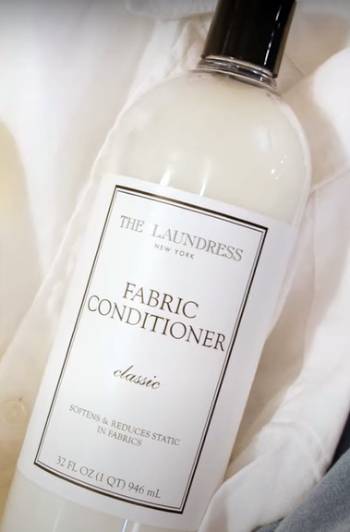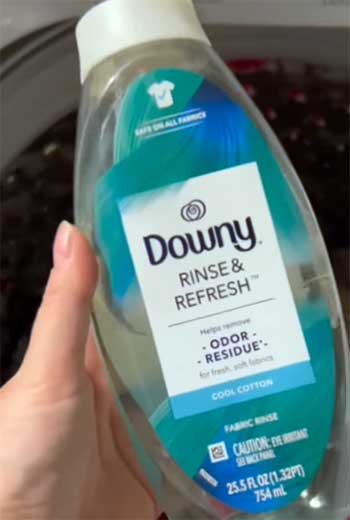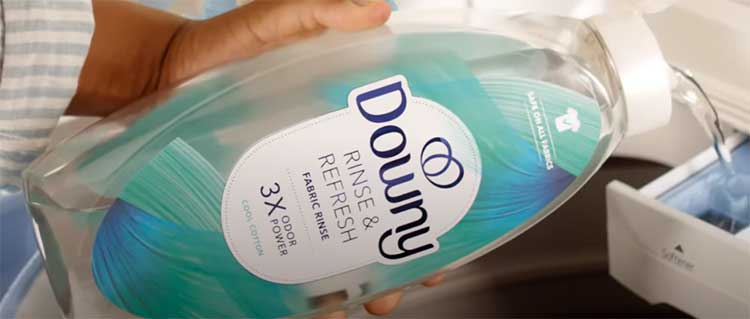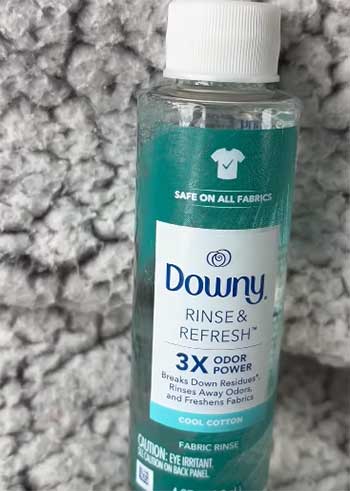I’ve spent years tossing clothes into the washer, hoping they’d come out soft, fresh, and ready to wear. But lately, I’ve been wondering if my trusty fabric softener is the best choice—or if something like Downy Rinse & Refresh could shake up my laundry routine.
In this article, I’m breaking down the differences between these two products, weighing their pros and cons, and sharing what I’ve learned from using them. My goal? To help you decide which one deserves a spot in your laundry room.
A Brief Comparison Table
| Feature | Downy Rinse & Refresh | Traditional Fabric Softener |
| Primary Function | Odor removal, residue dissolution | Softening fabrics, reducing static |
| Key Ingredients | Low pH surfactants, fragrance | Cationic surfactants, fragrance |
| Application | Added to fabric softener dispenser | Added to rinse cycle or dryer (sheets) |
| Residue | Minimal, dissolves buildup | Can leave waxy coating |
| Best For | Odor-prone clothes, activewear | Everyday softening, static control |
| Skin Sensitivity | Moderate (fragrance may irritate) | Varies (some are dye-free, hypoallergenic) |
| Environmental Impact | Moderate (concentrated formula) | Higher (potential buildup in machines) |
| Cost per Load | ~$0.15–$0.25 | ~$0.10–$0.20 (liquid or sheets) |
My Laundry Journey: Why I Started Questioning Fabric Softener?
For as long as I can remember, fabric softener was a staple in my laundry routine. That familiar floral scent and the promise of cuddly towels kept me loyal. But then I noticed my gym clothes smelling funky even after washing, and my towels weren’t absorbing water like they used to.
A quick scroll through cleaning forums introduced me to Downy Rinse & Refresh, marketed as a residue-busting, odor-fighting alternative. Intrigued, I decided to put both products to the test. What makes them different?
And is one truly better than the other? Let’s unpack this.
Understanding Fabric Softener: The Classic Choice

Fabric softener has been a laundry room MVP for decades. Its job is simple: make clothes feel softer, smell fresher, and reduce static cling.
Most fabric softeners, whether liquid or dryer sheets, use cationic surfactants—compounds that coat fabrics with a slippery layer.
This coating smooths out rough fibers, giving that “just-softened” feel.
I love how my sweaters feel like a warm hug after a wash with fabric softener, and the static-free finish is a lifesaver in winter.
But there’s a catch. That same coating can build up over time, especially on towels, activewear, and synthetic fabrics. I noticed my gym leggings felt waxy, and my towels were practically repelling water.
Experts, like those at Consumer Reports, warn that this residue can reduce absorbency and trap odors, making clothes smell musty. Plus, fabric softener can leave gunk in your washing machine, leading to mold and mildew if you’re not diligent about cleaning it.
Downy Rinse & Refresh: A New Kid on the Block

Enter Downy Rinse & Refresh, a product that promises to tackle the downsides of traditional fabric softener.
Unlike its softening-focused cousin, Rinse & Refresh uses a low pH formula with surfactants designed to dissolve odor-causing residues and buildup.
Downy markets it as a “clarifying shampoo” for your laundry, stripping away the gunk that traps smells.
I was skeptical but curious—could this really make my workout gear smell fresh again?
You add Rinse & Refresh to the fabric softener dispenser, and it releases during the rinse cycle.
It’s not about softening (though it does leave clothes feeling decently soft); it’s about cleaning deeper.
Available in scents like Cool Cotton and Lavender, it’s formulated for odor-prone fabrics like activewear or sweaty summer clothes. After my first wash, I was impressed—my gym shorts smelled clean, not like a locker room.
Key Features of Fabric Softener
Let’s break down what fabric softener brings to the table:
- Softening Power: Coats fibers to make clothes, towels, and sheets feel plush and smooth.
- Static Reduction: Neutralizes static cling, especially in dry climates or with synthetic fabrics.
- Fragrance Boost: Infuses laundry with long-lasting scents, from floral to fresh linen.
- Variety: Available in liquids, dryer sheets, and scent beads, with options like dye-free or hypoallergenic for sensitive skin.
- Ease of Use: Add to the rinse cycle or toss a sheet in the dryer—simple and familiar.
I’ve always appreciated how fabric softener transforms stiff jeans into something cozy. But the residue issue is real. After years of use, I started wondering if my clothes were clean or just coated in a scented film.
Key Features of Downy Rinse & Refresh
Downy Rinse & Refresh flips the script with these standout features:
- Odor Elimination: Targets and dissolves residues that trap smells, ideal for gym clothes or musty towels.
- Residue Removal: Low pH formula strips away buildup from detergent, softener, or hard water.
- Vibrant Colors: Claims to keep fabrics looking brighter by removing dulling residues.
- Concentrated Formula: A little goes a long way, reducing waste compared to some softeners.
- Scent Options: Offers fresh scents like Cool Cotton, though fewer choices than traditional softeners.
The first time I used Rinse & Refresh, I was amazed at how crisp my clothes felt—like they’d been deep-cleaned. But it’s not a one-size-fits-all solution, as I learned.
Pros of Fabric Softener
Fabric softener has earned its place in laundry rooms for good reason. Here’s why I still reach for it:
- Unmatched Softness: Nothing beats the cloud-like feel of a freshly softened blanket. It’s comfort in a bottle.
- Static Control: In winter, when my clothes crackle like a lightning storm, fabric softener keeps things calm.
- Affordable: At roughly $0.10–$0.20 per load, it’s budget-friendly, especially with dryer sheets.
- Wide Availability: From Downy to store brands, you’ll find options everywhere, including hypoallergenic versions.
- Long-Lasting Scent: My clothes smell amazing for days, which is a mood-lifter.
For everyday loads like T-shirts or bed linens, fabric softener is hard to beat. It’s like giving your laundry a spa day.
Cons of Fabric Softener
But it’s not all rosy. Here’s where fabric softener falls short:
- Residue Buildup: That waxy coating can make towels less absorbent and trap odors in activewear.
- Machine Gunk: Over time, softener can leave a film in your washer, leading to mold or mildew.
- Skin Irritation: Fragrances and chemicals can irritate sensitive skin, even in some “gentle” formulas.
- Environmental Impact: Many softeners aren’t eco-friendly, and their residue can affect water systems.
- Not Ideal for All Fabrics: Experts warn against using it on microfiber, athletic wear, or flame-resistant clothing.
I learned the hard way that my gym clothes were suffering. The softener I loved was making them smell worse, not better.
Pros of Downy Rinse & Refresh

Downy Rinse & Refresh has some serious strengths:
- Odor-Busting Power: It’s a lifesaver for smelly gym clothes or musty linens. My workout gear finally smells clean.
- Buildup Removal: It strips away residue, making fabrics feel crisp and colors look brighter.
- Better for Activewear: Unlike softener, it doesn’t clog moisture-wicking fabrics, so my leggings stay functional.
- Concentrated Efficiency: A small capful does the job, so the bottle lasts longer than I expected.
- Machine-Friendly: Less likely to leave gunk in your washer compared to traditional softener.
For odor-prone loads, Rinse & Refresh feels like a reset button for my laundry.
Cons of Downy Rinse & Refresh
It’s not perfect, though. Here’s where it stumbles:
- Limited Softening: It doesn’t match the plush softness of fabric softener. My towels felt clean but not cuddly.
- Fragrance Concerns: The scents are strong, which might irritate sensitive skin or noses.
- Higher Cost: At $0.15–$0.25 per load, it’s pricier than basic softeners or dryer sheets.
- Not a Full Replacement: If softness is your priority, you might still need softener for some loads.
- Learning Curve: Figuring out the right amount to use took trial and error to avoid over-scenting.
I found myself missing the cozy feel of softener for my sheets and blankets.
My Real-World Test: Putting Them To the Test
To get a clear picture, I ran a side-by-side experiment. I washed two loads of laundry: one with Downy April Fresh fabric softener and one with Downy Rinse & Refresh in Cool Cotton. Each load included gym clothes, towels, and cotton T-shirts—items that highlight the strengths and weaknesses of both products.
The fabric softener load came out soft and fragrant, but my towels felt slightly slick and didn’t soak up water well. The gym clothes smelled okay but had a faint musty undertone after a day in the hamper.
The Rinse & Refresh load, on the other hand, was a revelation for the gym clothes—they smelled truly clean, with no lingering odor. The towels were absorbent again, but they lacked that plush softness I love. The T-shirts felt similar in both loads, though the Rinse & Refresh ones looked slightly brighter.
When To Use Fabric Softener?
Fabric softener shines in these scenarios:
- Everyday Comfort: For sheets, blankets, or casual clothes where softness is king.
- Static-Prone Fabrics: Think sweaters or synthetic blends in dry weather.
- Budget-Friendly Loads: When you want a quick, affordable softness boost.
- Scent Lovers: If you crave that long-lasting laundry-fresh smell.
I still use fabric softener for my bedding because nothing else makes it feel as cozy.
When To Use Downy Rinse & Refresh?
Rinse & Refresh is your go-to for:
- Odor-Heavy Loads: Gym clothes, pet bedding, or musty towels.
- Activewear: Preserves the performance of moisture-wicking fabrics.
- Buildup Reset: When your laundry feels dull or less absorbent.
- Deep Cleaning: For refreshing fabrics without adding a waxy layer.
It’s now my default for workout gear and kitchen towels.
- Environmental and Practical Considerations

Fabric softener’s environmental footprint is a concern.
The chemicals in many formulas don’t break down easily, and the residue can affect water systems.
Dryer sheets are particularly wasteful, as they’re single-use and often non-recyclable.
Rinse & Refresh, while not perfect, uses a concentrated formula, meaning less product per load and less packaging waste.
However, its surfactants and fragrances still raise questions for eco-conscious folks.
Practically, Rinse & Refresh is slightly trickier to use.
You need to measure carefully to avoid overdoing the scent, and it’s only meant for the fabric softener dispenser. Fabric softener, whether liquid or sheets, is more forgiving and versatile.
- Which Is More Wallet-Friendly?
Let’s talk money. A 64-ounce bottle of Downy Rinse & Refresh costs about $10–$12 and handles 40–50 loads, averaging $0.20 per load. A similar-sized bottle of fabric softener (like Downy April Fresh) costs $8–$10 for 60–70 loads, or about $0.14 per load.
Dryer sheets are even cheaper, at $0.10 per load, but they’re less effective for heavy-duty softening.
If budget is your main concern, fabric softener wins. But if you’re dealing with odor issues or want to extend the life of your activewear, Rinse & Refresh’s higher cost might be worth it.
Which One Wins?
After weeks of testing, I don’t think it’s a clear-cut winner. Fabric softener is still my pick for cozy, everyday loads where softness and scent are non-negotiable. But Downy Rinse & Refresh has earned a permanent spot for my smelly gym clothes and towels that need a deep clean.
I’ve even started alternating them—softener for bedding, Rinse & Refresh for activewear—to get the best of both worlds.
Your choice depends on your priorities. Love soft, fragrant clothes and don’t mind occasional buildup? Stick with fabric softener. Dealing with stubborn odors or residue? Give Rinse & Refresh a try.
Either way, you’ll likely need to clean your washer regularly to keep things fresh.
Frequently Asked Questions (FAQ)
No, Rinse & Refresh focuses on odor removal and residue dissolution, while fabric softener prioritizes softening and static control.
Yes, its low pH formula effectively dissolves mildew-causing residues, reducing musty odors.
It’s excellent for odor-prone fabrics like activewear but less effective for softening compared to traditional softener.
Downy offers both Rinse & Refresh (odor and residue focus) and traditional fabric softeners (softening and scent focus).
Conclusion: Your Laundry, Your Choice
You’ve got options when it comes to keeping your laundry fresh and functional. I’ve shared my experience with Downy Rinse & Refresh and fabric softener, and now it’s up to you to decide what fits your needs.
Whether you’re chasing softness, battling odors, or balancing both, there’s a product for you. Try experimenting like I did—mix and match based on your loads. Your clothes (and your nose) will thank you.

Rinse and Refresh wins hands down for me. I loathe things that build up over time.